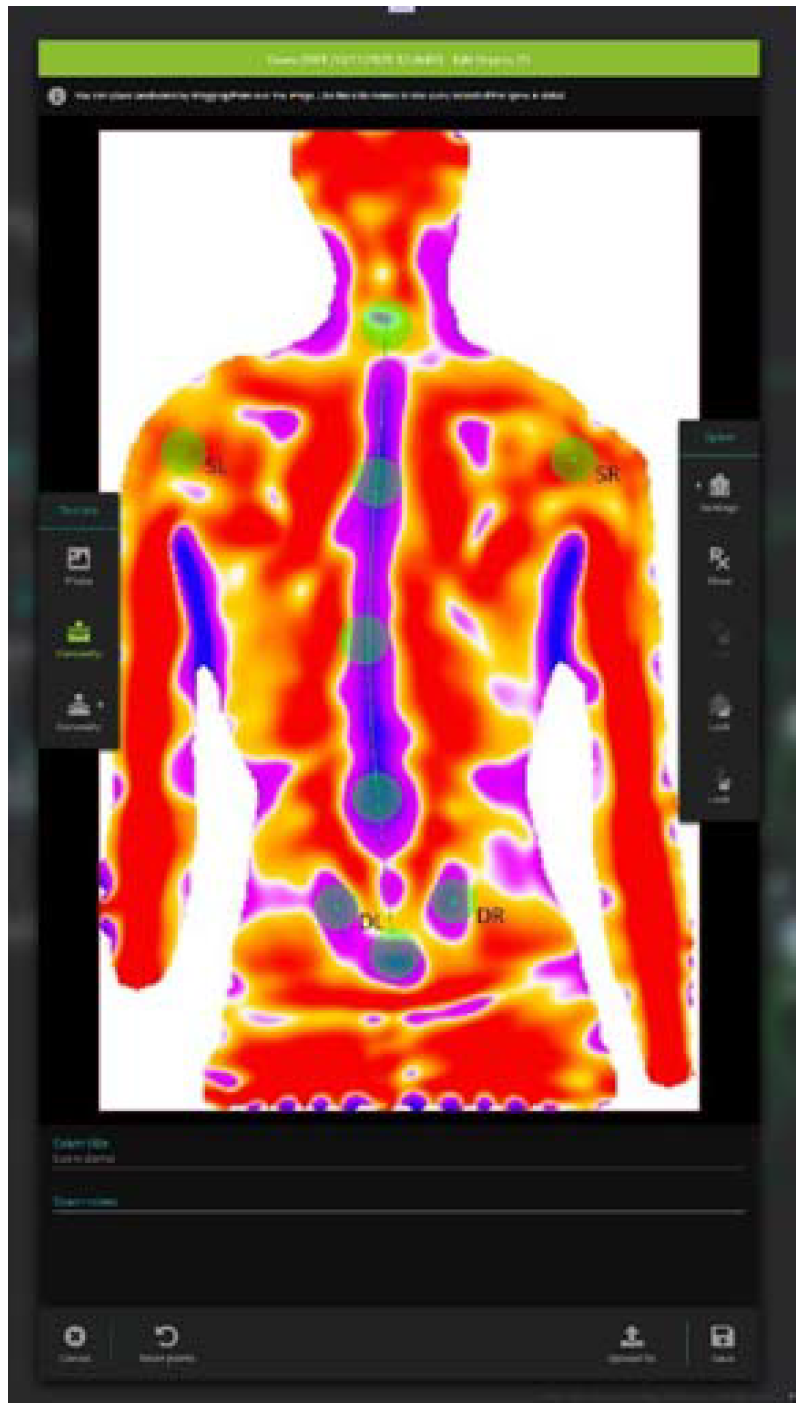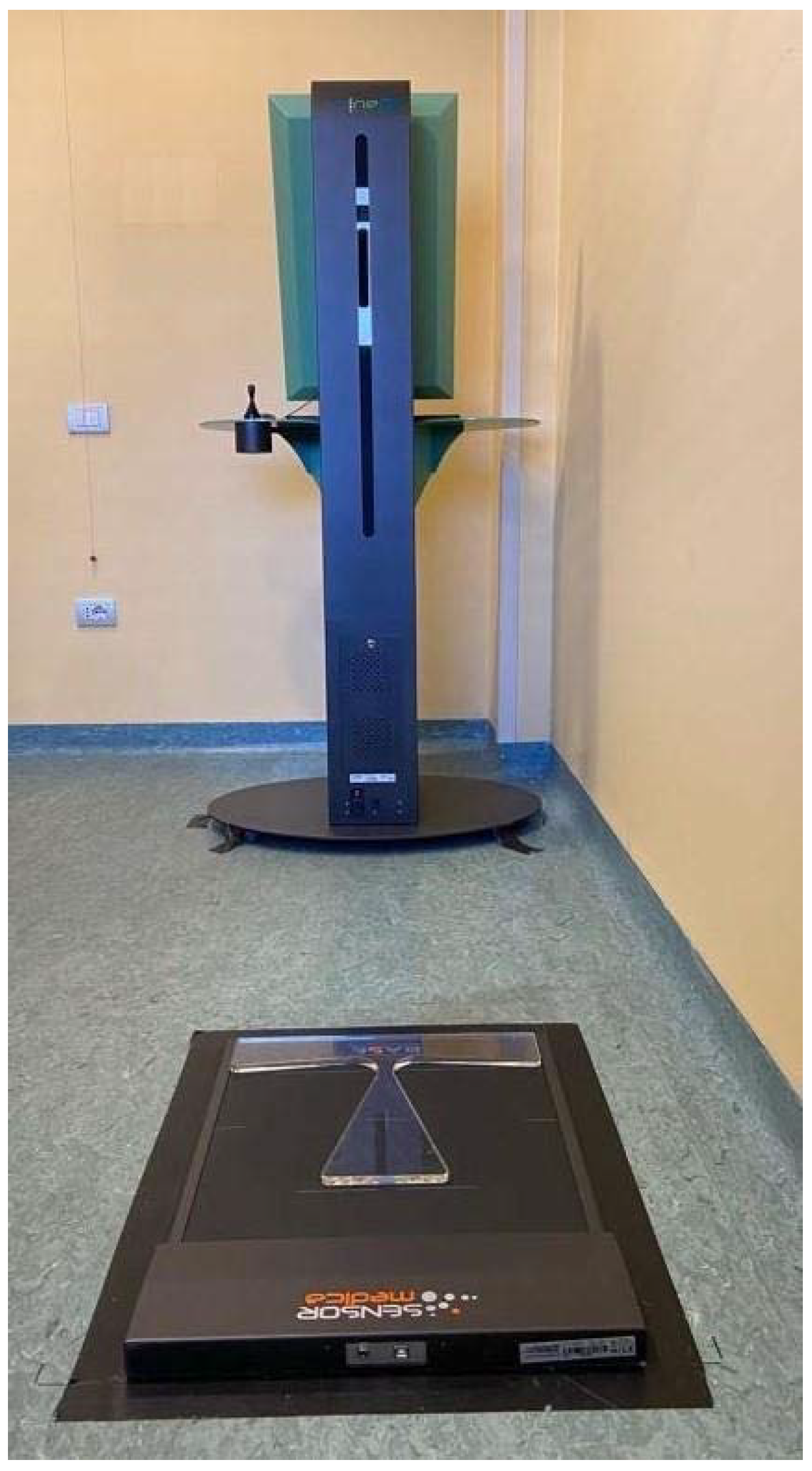Acute Effects of Self-Correction on Spine Deviation and Balance in Adolescent Girls with Idiopathic Scoliosis
Abstract
:1. Introduction
2. Materials and Methods
2.1. Study Design and Participants
2.2. Anthropometric Measurements
2.3. Instruments
2.4. Procedures
2.5. Statistical and Data Analysis
3. Results
4. Discussion
5. Conclusions
Author Contributions
Funding
Institutional Review Board Statement
Informed Consent Statement
Data Availability Statement
Conflicts of Interest
References
- Asher, M.A.; Burton, D.C. Adolescent idiopathic scoliosis: Natural history and long term treatment effects. Scoliosis 2006, 1, 2. [Google Scholar] [CrossRef] [PubMed] [Green Version]
- Weinstein, S.L.; Dolan, L.A.; Cheng, J.C.; Danielsson, A.; Morcuende, J.A. Adolescent idiopathic scoliosis. Lancet 2008, 371, 1527–1537. [Google Scholar] [CrossRef] [Green Version]
- Goldberg, M.S.; Mayo, N.E.; Poitras, B.; Scott, S.; Hanley, J. The ste-justine adolescent idiopathic scoliosis cohort study. Part II: Perception of health, self and body image, and participation in physical activities. Spine 1994, 19, 1562–1572. [Google Scholar] [CrossRef] [PubMed]
- Nachemson, A.L.; Peterson, L.E. Effectiveness of treatment with a brace in girls who have adolescent idiopathic scoliosis. A prospective, controlled study based on data from the Brace Study of the Scoliosis Research Society. J. Bone Jt. Surg. Am. 1995, 77, 815–822. [Google Scholar] [CrossRef]
- Weinstein, S.L.; Dolan, L.A.; Wright, J.G.; Dobbs, M.B. Effects of bracing in adolescents with idiopathic scoliosis. N. Engl. J. Med. 2013, 369, 1512–1521. [Google Scholar] [CrossRef] [PubMed] [Green Version]
- Negrini, S.; Donzelli, S.; Aulisa, A.G.; Czaprowski, D.; Schreiber, S.; De Mauroy, J.C.; Diers, H.; Grivas, T.B.; Knott, P.; Kotwicki, T.; et al. 2016 SOSORT guidelines: Orthopaedic and rehabilitation treatment of idiopathic scoliosis during growth. Scoliosis Spinal. Disord. 2018, 13, 3. [Google Scholar] [CrossRef] [PubMed] [Green Version]
- Fusco, C.; Zaina, F.; Atanasio, S.; Romano, M.; Negrini, A.; Negrini, S. Physical exercises in the treatment of adolescent idiopathic scoliosis: An updated systematic review. Physiother. Theory. Pract. 2011, 27, 80–114. [Google Scholar] [CrossRef] [PubMed]
- Dufvenberg, M.; Adeyemi, F.; Rajendran, I.; Öberg, B.; Abbott, A. Does postural stability differ between adolescents with idiopathic scoliosis and typically developed? A systematic literature review and meta-analysis. Scoliosis Spinal Disord. 2018, 13, 19. [Google Scholar] [CrossRef]
- Le Berre, M.; Guyot, M.A.; Agnani, O.; Bourdeauducq, I.; Versyp, M.C.; Donze, C.; Thévenon, A.; Catanzariti, J.F. Clinical balance tests, proprioceptive system and adolescent idiopathic scoliosis. Eur. Spine J. 2017, 26, 1638–1644. [Google Scholar] [CrossRef]
- Ceballos Laita, L.; Tejedor Cubillo, C.; Mingo Gómez, T.; Jiménez Del Barrio, S. Effects of corrective, therapeutic exercise techniques on adolescent idiopathic scoliosis. A systematic review. Archivos Argentinos Pediatria 2018, 116, e582–e589. (In Spanish) [Google Scholar]
- Monticone, M.; Ambrosini, E.; Cazzaniga, D.; Rocca, B.; Ferrante, S. Active self-correction and task-oriented exercises reduce spinal deformity and improve quality of life in subjects with mild adolescent idiopathic scoliosis. Results of a randomised controlled trial. Eur. Spine J. 2014, 23, 1204–1214. [Google Scholar] [CrossRef] [PubMed]
- Duarte, M.; Freitas, S.M. Revision of posturography based on force plate for balance evaluation. Rev. Bras. Fisioter. 2010, 14, 183–192. [Google Scholar] [CrossRef] [PubMed] [Green Version]
- Correale, L.; Carnevale Pellino, V.; Marin, L.; Febbi, M.; Vandoni, M. Comparison of an inertial measurement unit system and baropodometric platform for measuring spatiotemporal parameters and walking speed in healthy adults. Motor. Control 2020, 25, 89–99. [Google Scholar] [CrossRef]
- Baldini, A.; Nota, A.; Assi, V.; Ballanti, F.; Cozza, P. Intersession reliability of a posturo-stabilometric test, using a force platform. J. Electromyogr. Kinesiol. 2013, 23, 1474–1479. [Google Scholar] [CrossRef] [PubMed] [Green Version]
- Taylor, M.R.; Sutton, E.E.; Diestelkamp, W.S.; Bigelow, K.E. Subtle differences during posturography testing can influence postural sway results: The effects of talking, time before data acquisition, and visual fixation. J. Appl. Biomech. 2015, 31, 324–329. [Google Scholar] [CrossRef] [PubMed]
- Lovecchio, N.; Zago, M.; Perucca, L.; Sforza, C. Short-term repeatability of stabilometric assessments. J. Mot. Behav. 2017, 49, 123–128. [Google Scholar] [CrossRef]
- Marin, L.; Kawczyński, A.; Carnevale Pellino, V.; Febbi, M.; Silvestri, D.; Pedrotti, L.; Lovecchio, N.; Vandoni, M. Displacement of centre of pressure during rehabilitation exercise in adolescent idiopathic scoliosis patients. J. Clin. Med. 2021, 10, 2837. [Google Scholar] [CrossRef]
- Raso, V.J.; Lou, E.; Hill, D.L.; Mahood, J.K.; Moreau, M.J.; Durdle, N.G. Trunk distortion in adolescent idiopathic scoliosis. J. Pediatr. Orthop. 1998, 18, 222–226. [Google Scholar] [CrossRef]
- Nash, C.L., Jr.; Gregg, E.C.; Brown, R.H.; Pillai, K. Risks of exposure to X-rays in patients undergoing long-term treatment for scoliosis. J. Bone Jt. Surg. Am. 1979, 61, 371–374. [Google Scholar] [CrossRef]
- Kleinerman, R.A. Cancer risks following diagnostic and therapeutic radiation exposure in children. Pediatr. Radiol. 2006, 36, 121–125. [Google Scholar] [CrossRef] [Green Version]
- Betsch, M.; Wild, M.; Rath, B.; Tingart, M.; Schulze, A.; Quack, V. Radiation-free diagnosis of scoliosis: An overview of the surface and spine topography. Orthopade 2015, 44, 845–851. (In German) [Google Scholar] [CrossRef] [PubMed]
- Hierholzer, E.; Hackenberg, L. Three-dimensional shape analysis of the scoliotic spine using MR tomography and rasterstereography. Stud. Health Technol. Inform. 2002, 91, 184–189. [Google Scholar] [PubMed]
- Tommasi, D.G.; Foppiani, A.C.; Galante, D.; Lovecchio, N.; Sforza, C. Active head and cervical range of motion: Effect of age in healthy females. Spine 2009, 34, 1910–1916. [Google Scholar] [CrossRef] [PubMed]
- Liljenqvist, U.; Halm, H.; Hierholzer, E.; Drerup, B.; Weiland, M. 3-dimensional surface measurement of spinal deformities with video rasterstereography. Z. Orthop. Ihre. Grenzgeb. 1998, 136, 57–64. (In German) [Google Scholar] [CrossRef]
- Bassani, T.; Stucovitz, E.; Galbusera, F.; Brayda-Bruno, M. Is rasterstereography a valid noninvasive method for the screening of juvenile and adolescent idiopathic scoliosis? Eur. Spine J. 2019, 28, 526–535. [Google Scholar] [CrossRef]
- Drerup, B.; Ellger, B.; Meyer zu Bentrup, F.M.; Hierholzer, E. Functional rasterstereographic images. A new method for biomechanical analysis of skeletal geometry. Orthopade 2001, 30, 242–250. (In German) [Google Scholar] [CrossRef]
- Betsch, M.; Wild, M.; Johnstone, B.; Jungbluth, P.; Hakimi, M.; Kühlmann, B.; Rapp, W. Evaluation of a novel spine and surface topography system for dynamic spinal curvature analysis during gait. PLoS ONE. 2013, 8, e70581. [Google Scholar] [CrossRef]
- Betsch, M.; Wild, M.; Jungbluth, P.; Hakimi, M.; Windolf, J.; Haex, B.; Horstmann, T.; Rapp, W. Reliability and validity of 4D rasterstereography under dynamic conditions. Comput. Biol. Med. 2011, 41, 308–312. [Google Scholar] [CrossRef]
- Sim, T.; Yoo, H.; Lee, D.; Suh, S.W.; Yang, J.H.; Kim, H.; Mun, J.H. Analysis of sensory system aspects of postural stability during quiet standing in adolescent idiopathic scoliosis patients. J. Neuroeng. Rehabil. 2018, 15, 54. [Google Scholar] [CrossRef]
- World Medical Association. World Medical Association Declaration of Helsinki: Ethical principles for medical research involving human subjects. JAMA 2013, 310, 2191–2194. [Google Scholar] [CrossRef] [Green Version]
- Cobb, J.R. Scoliosis; quo vadis. J. Bone Jt. Surg. Am. 1958, 40, 507–510. [Google Scholar] [CrossRef]
- Risser, J.C. The classic: The iliac apophysis: An invaluable sign in the management of scoliosis. Clin. Orthop. Relat. Res. 2010, 468, 643–653. [Google Scholar] [CrossRef] [PubMed] [Green Version]
- Nault, M.L.; Allard, P.; Hinse, S.; Le Blanc, R.; Caron, O.; Labelle, H.; Sadeghi, H. Relations between standing stability and body posture parameters in adolescent idiopathic scoliosis. Spine 2002, 27, 1911–1917. [Google Scholar] [CrossRef]
- Chow, D.H.; Kwok, M.L.; Cheng, J.C.; Lao, M.L.; Holmes, A.D.; Au-Yang, A.; Yao, F.Y.; Wong, M.S. The effect of backpack weight on the standing posture and balance of schoolgirls with adolescent idiopathic scoliosis and normal controls. Gait Posture 2006, 24, 173–181. [Google Scholar] [CrossRef] [PubMed]
- Dupuis, S.; Fortin, C.; Caouette, C.; Leclair, I.; Aubin, C.É. Global postural re-education in pediatric idiopathic scoliosis: A biomechanical modeling and analysis of curve reduction during active and assisted self-correction. BMC Musculoskelet. Disord. 2018, 19, 200. [Google Scholar] [CrossRef] [PubMed]
- Neumann, D.A. Kinesiology of the Musculoskeletal System—Foundations for Rehabilitation; Elsevier: Amsterdam, The Netherlands, 2010. [Google Scholar]
- Wiernicka, M.; Kotwicki, T.; Kamińska, E.; Łochyński, D.; Kozinoga, M.; Lewandowski, J.; Kocur, P. Postural stability in adolescent girls with progressive idiopathic scoliosis. Biomed. Res. Int. 2019, 2019, 7103546. [Google Scholar] [CrossRef] [PubMed]
- Gür, G.; Ayhan, C.; Yakut, Y. The effectiveness of core stabilization exercise in adolescent idiopathic scoliosis: A randomized controlled trial. Prosthet. Orthot. Int. 2017, 41, 303–310. [Google Scholar] [CrossRef] [PubMed]
- Marin, L.; Lovecchio, N.; Kawczynski, A.; Febbi, M.; Silvestri, D.; Pellino, V.C.; Gibellini, R.; Vandoni, M. Intensive rehabilitation program in arterial occlusive disease patients. Appl. Sci. 2021, 11, 1184. [Google Scholar] [CrossRef]


| Total Sample (n = 36) | |
|---|---|
| Age (years) | 14 (2.0; 13.0–15.0) |
| Body mass (kg) | 52.2 (9.9; 45.6–55.5) |
| Stature (m) | 1.60 (1.0; 1.5–1.6) |
| BMI (kg/m2) | 19.5 (3.9; 18.0–21.9) |
| Cobb (°) | 14 (9.0; 10.0–19.0) |
| Risser | 3 (2.0; 2.0–4.0) |
| Median (IQR; 25–75th) | p-Value | ES | ||
|---|---|---|---|---|
| EE | SP | 0.5 (0.4; 0.3–0.8) | 0.002 * | 0.6984 |
| SC | 0.3 (0.3; 0.1–0.5) | |||
| Sway X (mm) | SP | 9.6 (5.2; 6.5–11.7) | 0.050 * | 0.4161 |
| SC | 7.4 (3.3; 6.0–9.4) | |||
| Sway Y (mm) | SP | 8.3 (3.6; 6.6–10.2) | 0.749 | −0.0713 |
| SC | 9.2 (3.4; 7.3–10.2) | |||
| SA (cm2) | SP | 95.6 (98.0; 50.5–148.6) | 0.035 * | 0.4483 |
| SC | 59.4 (49.3; 37.9–87.2) | |||
| VLD (mm) | SP | 5.4 (4.0; 3.1–7.1) | 0.020 * | 0.4897 |
| SC | 3.8 (2.7; 2.4–5.1) |
Publisher’s Note: MDPI stays neutral with regard to jurisdictional claims in published maps and institutional affiliations. |
© 2022 by the authors. Licensee MDPI, Basel, Switzerland. This article is an open access article distributed under the terms and conditions of the Creative Commons Attribution (CC BY) license (https://creativecommons.org/licenses/by/4.0/).
Share and Cite
Marin, L.; Lovecchio, N.; Pedrotti, L.; Manzoni, F.; Febbi, M.; Albanese, I.; Patanè, P.; Carnevale Pellino, V.; Vandoni, M. Acute Effects of Self-Correction on Spine Deviation and Balance in Adolescent Girls with Idiopathic Scoliosis. Sensors 2022, 22, 1883. https://doi.org/10.3390/s22051883
Marin L, Lovecchio N, Pedrotti L, Manzoni F, Febbi M, Albanese I, Patanè P, Carnevale Pellino V, Vandoni M. Acute Effects of Self-Correction on Spine Deviation and Balance in Adolescent Girls with Idiopathic Scoliosis. Sensors. 2022; 22(5):1883. https://doi.org/10.3390/s22051883
Chicago/Turabian StyleMarin, Luca, Nicola Lovecchio, Luisella Pedrotti, Federica Manzoni, Massimiliano Febbi, Ilaria Albanese, Pamela Patanè, Vittoria Carnevale Pellino, and Matteo Vandoni. 2022. "Acute Effects of Self-Correction on Spine Deviation and Balance in Adolescent Girls with Idiopathic Scoliosis" Sensors 22, no. 5: 1883. https://doi.org/10.3390/s22051883
APA StyleMarin, L., Lovecchio, N., Pedrotti, L., Manzoni, F., Febbi, M., Albanese, I., Patanè, P., Carnevale Pellino, V., & Vandoni, M. (2022). Acute Effects of Self-Correction on Spine Deviation and Balance in Adolescent Girls with Idiopathic Scoliosis. Sensors, 22(5), 1883. https://doi.org/10.3390/s22051883








